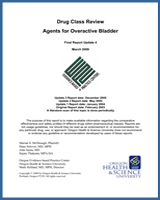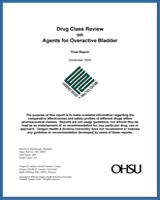NCBI Bookshelf. A service of the National Library of Medicine, National Institutes of Health.
McDonagh MS, Selover D, Santa J, et al. Drug Class Review on Agents for Overactive Bladder: Final Report [Internet]. Portland (OR): Oregon Health & Science University; 2005 Dec.
This publication is provided for historical reference only and the information may be out of date.
Results for the key questions are summarized in Table 1.
Table 1
Summary of the Evidence.
Flavoxate
We found no fair or good quality evidence to assess flavoxate in head-to-head comparisons with oxybutynin or tolterodine. In comparison to the results found in oxybutynin or tolterodine studies, a study of flavoxate compared to another drug (emepronium) indicated a lower response on objective outcome measures, and varying response on subjective measures. Flavoxate was not superior to placebo in the two included trials. The evidence on flavoxate was inadequate to assess efficacy or adverse events compared to oxybutynin or tolterodine.
Scopolamine
There were no head-to-head studies identified for scopolamine. One two-week placebo-controlled trial in a small number of women (n=20) diagnosed with detrusor instability showed greater improvements in diurnal frequency, nocturia, urgency, and urge incontinence with scopolamine than placebo
Hyoscyamine
There were no head-to-head studies for hyoscyamine.
Evidence of Comparative Efficacy: Oxybutynin versus Tolterodine
Because both drugs are available in immediate and extended release formulations, several comparisons can be made (IR vs IR, oxybutynin ER vs tolterodine IR, tolterodine ER vs oxybutynin IR, oxybutynin IR vs oxybutynin ER, tolterodine ER vs tolterodine IR, and ER vs ER). The comparisons of the IR formulations do not demonstrate a difference based on objective or subjective efficacy measures. The strength of this evidence is good. The comparisons of the two ER formulations reported tolterodine 4mg daily to be superior based on subjective assessments of symptoms in one study, and oxybutynin ER to be superior on some outcome measures (mean micturitions, and proportion without incontinence) but not others (urge incontinence and total incontinence episodes). Because there are important concerns about selection bias and potential confounding in the first study, the strength of this evidence is fair.
The comparison of each drug's IR formulation to its ER formulation did not demonstrate important differences in efficacy measures, but there are only two studies of oxybutynin and one of tolterodine. A single study compared the ER formulation of oxybutynin to the IR formulation of tolterodine, and found statistically significant evidence that oxybutynin ER was superior based on objective measures. This study did not use an intention to treat analysis, thus the effect of dropouts on overall efficacy was not accounted for, weakening the strength of this evidence. A single study of tolterodine ER compared to oxybutynin IR found tolterodine to be equal in efficacy measures (objective and subjective).
The transdermal formulation of oxybutynin has been compared to oxybutynin IR and tolterodine ER, with no difference in efficacy measure outcomes. The comparison of TD to tolterodine ER also found no difference in efficacy measures.
Evidence of Comparative Efficacy: Oxybutynin versus Trospium
Two comparative trials were found for oxybutynin IR vs. trospium and three placebo controlled trials for trospium. One comparative trial followed patients for an average of 54 weeks. No significant differences in comparative efficacy were found in these trials. The results of placebo trials for trospium were similar to the comparative trial.
Evidence of Comparative Efficacy: Tolterodine versus Solifenacin
Two comparative trials were found for tolterodine (one with IR and the other with ER) compared to solifenacin. The comparative studies provide some mixed efficacy results. In the tolterodine IR versus solifenacin study, each drug was compared separately to placebo and then indirectly compared with each other. Both doses of solifenacin indirectly showed greater efficacy for two of four efficacy variables compared to tolterodine IR. The STAR trial also demonstrated mixed results with solifenacin showing greater efficacy than tolterodine in all but one of the secondary endpoints (nocturia was similar for both drugs). This study was designed as a "non-inferioirty" trial and found that solifenacin was non-inferior to tolterodine for the primary study endpoint, mean number of micturitions per 24 hours.
Evidence of Comparative Adverse Events: Oxybutynin versus Tolterodine
Adverse event rates for both drugs are relatively high. Dry mouth is the most commonly reported adverse event for both. Longer-term evidence is limited. A high discontinuation rate for both drugs was found in a six-month observational study of prescription claims data. But there was statistically significant evidence of a higher rate for oxybutynin IR. Adverse event, including dry mouth, and withdrawal rates were similar across 3- to 12-month uncontrolled studies.
Short-term comparative trials demonstrate that overall adverse event and dry mouth rates were significantly higher for oxybutynin IR compared to tolterodine IR. A reduction of adverse events and the proportion reporting dry mouth was reduced with the ER compared to the IR formulation of each drug. Oxybutynin ER was found to have significantly fewer adverse events overall compared to tolterodine IR, but the difference in reports of dry mouth did not reach statistical significance. In comparing the ER formulations, both studies found tolterodine ER to be slightly superior to oxybutynin ER in reports of adverse events, mainly focusing on dry mouth. Withdrawals in both studies however were similar between the groups. In a single study, comparison of oxybutynin IR was found to have higher adverse event rates than tolterodine ER. This trial found unusually high rates of reports of dry mouth with the oxybutynin compared to other studies. A separate subanalysis of CNS adverse events in a comparison of the ER formulations reported no statistically significant between-treatment differences.
The transdermal formulation of oxybutynin has been compared to oxybutynin IR and tolterodine ER. The comparison to oxybutynin IR found a significant difference only on the incidence of dry mouth. This study titrated the dose at every visit, with dose escalation until the occurrence of side effects required dose reduction. It is unclear that the highest dose level for each group is comparable (3.9mg/day TD, 20mg/day oral). The comparison of TD to tolterodine ER found a significant difference favoring tolterodine ER in the incidence of application site reactions, although the incidence of dry mouth was lower with oxybutynin TD, but did not reach statistical significance.
Withdrawals due to adverse events may be the more important measure. Comparisons of the IR formulations did not show a significant difference when comparing tolterodine 2mg twice daily to oxybutynin 5mg twice daily, but oxybutynin 5mg three times daily did result in significantly more withdrawals due to adverse events. The studies of comparing the ER versus IR formulations of each drug did not show a significant difference in the adverse event withdrawal rate. In a single study, tolterodine ER resulted in fewer withdrawals due to adverse events than oxybutynin IR. However, this study reported unusually high rates of dry mouth in the oxybutynin group.
The study comparing oxybutynin ER to tolterodine IR did not find a difference in withdrawal rate, even though the difference in overall adverse events and dry mouth was statistically significant. Since this study has some methodological problems of some concern, the results must be interpreted carefully. The larger, randomized controlled trial of the two ER formulations found no difference in withdrawal rates, though a smaller study reported a statistically significant difference in withdrawals due to adverse events, favoring tolterodine.
Although the difference in dry mouth reports was statistically significant, withdrawals due to adverse events with oxybutynin TD was not found to be different to oxybutynin IR, with one per group. The comparison of TD to tolterodine ER found a significant difference favoring tolterodine ER in the withdrawal rate due to adverse events (largely due to application site reactions).
Evidence of Comparative Adverse Events: Oxybutynin versus Trospium
Two comparative trials reported adverse events. In one, the incidence of dry mouth was similar in both groups but more oxybutynin IR patients reported severe dry mouth.27 This trial in which all patients had a spinal cord injury had comparable adverse events in both treatment groups with withdrawals slightly higher for oxybutynin In the other trial of 54 weeks duration, there was a higher incidence of dry mouth among oxybutynin IR patients compared to trospium patients.45 Overall adverse events were greater for oxybutynin than trospium but overall withdrawals were similar. Withdrawals thought to be related to adverse events were more likely for oxybutynin. However the overall rate of adverse events was high for both drugs in both studies.
Evidence of Comparative Adverse Events: Darifenacin versus Oxybutynin
In a single comparative trial of darifenacin and oxybutynin IR both drugs were comparable for visual nearpoint, a measure of anticholinergic effect on vision.
Evidence of Comparative Adverse Events: Solifenacin versus Tolterodine
The STAR trial reported significantly lower rates of dry mouth for tolterodine and lower rates of constipation for tolterodine, but similar rates of blurred vision. Differences in withdrawals due to adverse events were not significantly different.
Another study comparing solifenacin 5mg or 10mg and tolterodine IR reported the percentage of patients with dry mouth was greatest in the group taking 10mg of solifenacin followed by the group taking tolterodine, then by the group taking 5mg of solifenacin and finally, placebo. The rates of constipation were greatest for solifenacin 10mg followed by solifenacin 5mg, tolterodine, and placebo. Similarly, a higher percentage of patients reported blurred vision in the solifenacin 10mg group, followed by the 5mg group., placebo, and the tolterodine group. Withdrawals due to adverse events were lowest for patients receiving tolterodine followed by solifenacin 10mg, solifenacin 5mg and highest for the placebo group.
Evidence of Comparative Efficacy or Adverse Events in Subgroup: Oxybutynin versus Tolterodine or Trospium
Insufficient evidence was found. While individual studies indicate that there may be an association between age or gender and efficacy or adverse effects, no comparative studies were found except for spinal cord injured patients. In this study trospium was found to have a lower incidence of severe dry mouth than oxybutynin IR, though overall adverse effects were comparable. Efficacy outcomes included in this review were not reported in this trial.27
There was fair evidence from a subanalysis comparing oxybutynin ER to tolterodine IR that the oxybutynin ER may be significantly more effective for women <65 years. This study included a greater proportion of women in this age group. The incidence of adverse events was similar for both drugs.
- Flavoxate
- Scopolamine
- Hyoscyamine
- Evidence of Comparative Efficacy: Oxybutynin versus Tolterodine
- Evidence of Comparative Efficacy: Oxybutynin versus Trospium
- Evidence of Comparative Efficacy: Tolterodine versus Solifenacin
- Evidence of Comparative Adverse Events: Oxybutynin versus Tolterodine
- Evidence of Comparative Adverse Events: Oxybutynin versus Trospium
- Evidence of Comparative Adverse Events: Darifenacin versus Oxybutynin
- Evidence of Comparative Adverse Events: Solifenacin versus Tolterodine
- Evidence of Comparative Efficacy or Adverse Events in Subgroup: Oxybutynin versus Tolterodine or Trospium
- Summary and Discussion - Drug Class Review on Agents for Overactive BladderSummary and Discussion - Drug Class Review on Agents for Overactive Bladder
- Mus musculus phosphodiesterase 4B, cAMP specific, mRNA (cDNA clone IMAGE:3485809...Mus musculus phosphodiesterase 4B, cAMP specific, mRNA (cDNA clone IMAGE:3485809), partial cdsgi|13938078|gb|BC007155.1|Nucleotide
Your browsing activity is empty.
Activity recording is turned off.
See more...

